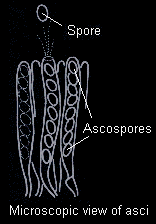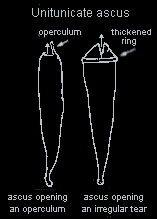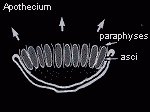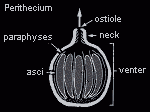Subdivision: Ascomycotina
 The ascospores are a result of fusion between two nuclei, either from the same individual or from two different but compatible mating strains. Meiosis follows fusion to produce four nuclei embedded in a common cytoplasm (the young ascus). In some species the cytoplasm becomes condensed around the nuclei to form four ascospores, but more commonly, a mitotic division takes place to form eight nuclei, resulting in the formation of eight ascospores. In some species, a series of mitosis divisions follows one another, resulting in the formation of twenty-four, thirty-two, sixty-four or more ascospores inside a much-inflated ascus.
The ascospores are a result of fusion between two nuclei, either from the same individual or from two different but compatible mating strains. Meiosis follows fusion to produce four nuclei embedded in a common cytoplasm (the young ascus). In some species the cytoplasm becomes condensed around the nuclei to form four ascospores, but more commonly, a mitotic division takes place to form eight nuclei, resulting in the formation of eight ascospores. In some species, a series of mitosis divisions follows one another, resulting in the formation of twenty-four, thirty-two, sixty-four or more ascospores inside a much-inflated ascus. Ascomycetes of this class have an ascus wall composed of a single layer (unitunicate). Inside each ascus flask, eight ascospores develop, bathed in a fluid, which is retained under pressure. When the spores are ripe, the neck of the ascus is designed to open with a shock stimulus. This is achieved either by the opening of a lid (operculum), or they may simply burst or break at maturity. A raindrop falling on the cup surface usually triggers this. The spores are then forcibly discharged into the damp air currents.
Ascomycetes of this class have an ascus wall composed of a single layer (unitunicate). Inside each ascus flask, eight ascospores develop, bathed in a fluid, which is retained under pressure. When the spores are ripe, the neck of the ascus is designed to open with a shock stimulus. This is achieved either by the opening of a lid (operculum), or they may simply burst or break at maturity. A raindrop falling on the cup surface usually triggers this. The spores are then forcibly discharged into the damp air currents. The asci are borne in a fertile layer or hymenium exposed in a cup or saucer-shaped fruit body known as an apothecium. Members of this group may have either operculate or inoperculate asci.
The asci are borne in a fertile layer or hymenium exposed in a cup or saucer-shaped fruit body known as an apothecium. Members of this group may have either operculate or inoperculate asci.
Family: BulgariaceaeOrder: Pezizales
Family: Cyttariaceae
Family: Leotiaceae
Family: Geoglossaceae
Family: Helotiaceae

Family: Discinaceae
Family: Pezizaceae
Family: Pyronemataceae
Family: Sarcoscyphaceae
Family: Sarcosomataceae
 Cylindrical asci are borne in a layer lining the inside of a flask-shaped structure, opened by a pore or ostiole at the top, called the perithecium. In many types, the perithecia themselves are embedded in sterile tissue known as a stroma, many of which make up one ascocarp.
Cylindrical asci are borne in a layer lining the inside of a flask-shaped structure, opened by a pore or ostiole at the top, called the perithecium. In many types, the perithecia themselves are embedded in sterile tissue known as a stroma, many of which make up one ascocarp.

Family: XylariaceaeOrder: Hypocreales
Family: HypocreaceaeOrder: Sordariales
Family: Clavicipitaceae

Family: LasiosphaeriaceaeOrder: Eurotiales
Family: Trichocomaceae
| |